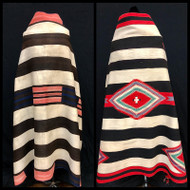Collector's Corner Chief's Blankets
Posted by Jim Olson on Jun 11th 2021
Although historically the Navajo people never really had any one person recognized as a “Chief” per-se, they are well known for their “Chief’s” blankets. A Chief’s blanket was said to be called such because only a “Chief” or a wealthy person could afford to own one—even in the 1800s they were expensive. According to Antiques Roadshow, a First Phase Chief’s blanket could be worth as much as one million dollars today! But just what is a Chief’s blanket?
A Chief’s blanket was a wearing blanket (usually worn similar to a shawl) and it also doubled as a blanket for sleeping with at night. Handmade by the Navajo, they were so well woven they were purported to be practically waterproof—this is the legend of a Chief’s blanket. Before the Navajo started weaving floor rugs for tourists consumption (after the 1870s), saddle blankets, clothing and wearing blankets (things they actually used) was what was made by the dexterous weavers.
The Three Phases
Beginning sometime during the 1700s, and until their decline in use about the late 1800s, there were three different styles or “Phases” the blankets went through. First, Second and Third Phase Chief’s blankets are how we refer to them today and each is identifiable by design.
First Phase Chief’s blankets are exceedingly rare. Estimates are that only around fifty of them are know to have survived the test of time and are in collections or museums today. First Phase blankets are recognizable because of their banded or striped pattern, usually made with indigo blue, brown and white stripes. Some later First Phase blankets may have small red stripes as well. The Utes were said to be a main customer for the Navajo weavers on the First Phase blankets and they are sometimes referred to as “Ute Style" First Phase blankets. First Phase blankets were made from the inception of Navajo blanket weaving (circa the 1700s) up until about 1840 or 50 when a new design began to appear. The style we now refer to as “Second Phase” Chief’s blankets.
Second Phase Chief’s blankets are identified as such because they were now accented with twelve rectangular blocks worked into the striped pattern. This new design appeared in history from about 1840 to the 1860s, give or take a little each side. It’s not like the transition took place overnight—it was a gradual process. Most second phase blankets now had red color to go with the indigo blue, brown and white. Second Phase Chief’s blankets are generally worth a good bit less than the elusive First Phase blankets, but they are still pretty valuable as there is not an excess of these available either. As we started getting into the last half of the 19th century, designs started changing again. Hence the Third Phase Chief’s blanket.
Third Phase Chief’s blankets can be identified by their nine diamonds which are now accented over the stripes. Additional colors also show up as weavers experimented more with dyes. Third Phase blankets are both the shortest lived and longest lived versions all at once.
You see, what most collectors consider an authentic Third Phase Chief’s blanket was only woven for about 10 years. These are blankets made strictly for wearing and sleeping with (just like first and second phase blankets were) before the end of late classic period (when the weavers started making floor rugs for traders and tourists and got away from making wearing blankets).
However, the Third Phase style blankets have endured longer than any other in the sense that this style is still regularly woven to this day. They were made both as wearing blankets and rugs during the transitional period and are still woven in the modern period (although some do refer to these as third phase variants or fourth phase blankets).
It is known in collector’s circles that Chief’s blankets made during the classic period (before 1863) are the ones most highly sought after. These are the only ones considered as truly authentic Chief’s blankets by some purist. They refer to any weaving made in the Chief’s blanket style after that time frame to be more of a rug than a wearing blanket. However, there were surely some wearing blankets still woven after the classic period (hence the term “transitional” period which is when they were “transitioning” from making blankets to rugs).
Also, let’s be sure and keep our “phases” and “periods” straight when talking about Navajo textiles. The three phases of Chief’s blankets refer to the three main styles or design changes the weavings went through (striped, striped with twelve rectangles and striped with nine diamonds). While the periods refer to periods of time (classic being pre-1863 and transitional being after that and up until around 1900).
As with any valuable collectible, rarity and condition have a lot to do with price. It is also very important to deal with an honest and reputable seller when purchasing one. As mentioned earlier, they are still making Chief’s blankets to this day, but you don’t want to pay a genuine First Phase price for something that is not worth that.
Western Trading Post can help you in gaining more knowledge of the rich Western History and lifestyle.
Here are some helpful links to explore further – Award-winning TV show, YouTube channel, and app.
Jim Olson © 2021

